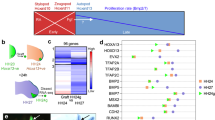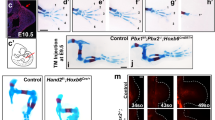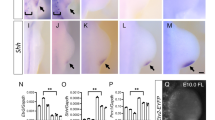Abstract
THE development of the chick limb may be viewed in terms of positional information; that is, the spatial pattern of cellular differentiation results from the cells interpreting their position in a three-dimensional coordinate system1. We have presented evidence that positional information along the antero–posterior axis is specified by a signal from the zone of polarising activity (ZPA), which is at the posterior margin of the wing bud2,3. Grafts of ZPA to anterior regions of an early bud result in mirror image duplication between grafted ZPA and host ZPA which is particularly evident in the pattern of the digits. The three digits of the chick wing4, digits 2, 3, and 4 appear to be specified by their distance from the nearest ZPA, digit 4 being closest, then digit 3 and then digit 2. The ZPA from the leg can also specify additional wing digits when grafted into the wing which suggests that the positional information along the antero–posterior axis in leg and wing is similar, but that interpretation differs. We therefore wanted to know whether a ZPA was present in other classes of vertebrates, and if so whether the signal from it was also similar. We investigated this question by grafting tissue from embryonic mouse limbs into developing chick wing buds.
This is a preview of subscription content, access via your institution
Access options
Subscribe to this journal
Receive 51 print issues and online access
$199.00 per year
only $3.90 per issue
Buy this article
- Purchase on Springer Link
- Instant access to full article PDF
Prices may be subject to local taxes which are calculated during checkout
Similar content being viewed by others
References
Wolpert, L., Lewis, J., and Summerbell, D., in Ciba Symposium on Cell Patterning, 29, 95–119 (Associated Scientific Press, Amsterdam, 1975).
Saunders, J. W., and Gasseling, M. T., in Epithelial-Mesenchymal Interactions (edit. by Fieischmayer, R. and Billingham, R. F.), 78–79 (Williams and Wilkins, Baltimore, 1968).
Tickle, C., Summerbell, D., and Wolpert, L., Nature, 254, 199–202 (1975).
Montagna, W., J. Morph., 76, 87–113 (1945).
Grüneberg, H., J. Hered., 34, 89–92 (1943).
Jurand, A., Proc. R. Soc., B 162, 387–405 (1965).
Dhouailly, D., J. Embryol. exp. Morph., 30, 587–603 (1973); Wilhelm Roux Arch. Entw Mech. Org., 177, 323–340 (1975).
Sengel, P., in Ciba Symposium on Cell Patterning, 29, 51–66 (Associated Scientific Press, Amsterdam, 1975).
Waddington, C. H., Archs Biol., 48, 273–290 (1937).
Author information
Authors and Affiliations
Rights and permissions
About this article
Cite this article
TICKLE, C., SHELLSWELL, G., CRAWLEY, A. et al. Positional signalling by mouse limb polarising region in the chick wing bud. Nature 259, 396–397 (1976). https://doi.org/10.1038/259396a0
Received:
Accepted:
Issue Date:
DOI: https://doi.org/10.1038/259396a0
This article is cited by
-
Making digit patterns in the vertebrate limb
Nature Reviews Molecular Cell Biology (2006)
-
Position-dependent expression of two related homeobox genes in developing vertebrate limbs
Nature (1991)
-
Coordinate expression of the murine Hox-5 complex homoeobox-containing genes during limb pattern formation
Nature (1989)
-
The role of parental positional information in the determination of antero-posterior polarity during palleal budding in ascidians
Wilhelm Roux's Archives of Developmental Biology (1983)
-
Evidence that patterning mechanisms in developing and regenerating limbs are the same
Nature (1982)
Comments
By submitting a comment you agree to abide by our Terms and Community Guidelines. If you find something abusive or that does not comply with our terms or guidelines please flag it as inappropriate.



